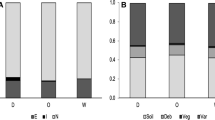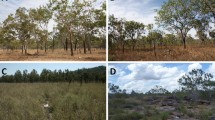Abstract
Ant assemblages present a great vertical stratification, with microhabitats showing strong differences in relation to species composition. Among the microhabitats, the hypogaeic has been poorly studied. Hypogaeic or subterranean ants live in the deeper soil layers, which make the sampling logistics and operability a difficult work. The fact that the hypogaeic ant fauna is diversified and abundant, with low similarity to ant assemblages in other microhabitats, has promoted the development of several collecting techniques to sample this hidden ant fauna. Here, we verify the ability of hypogaeic pitfall traps to sample subterranean ants. In addition, we propose methodological advances and remarks about the use of this ant sampling technique.

Similar content being viewed by others
References
Agosti D. and Johnson N.F. 2005. Antbase. World Wide Web Electronic Publication. antbase.org, version (05/2005), Accessed 25 Jan. 2010
Agosti D., Majer J.D., Alonso L.E., and Schultz T.R. 2000. Ants: Standard Methods for Measuring and Monitoring Biodiversity. Smithsonian Institution Press, Washington, 280 pp
Berghoff S.M., Maschwitz U. and Linsenmair K.E. 2003a. Hypogaeic and epigaeic ant diversity on Borneo: evaluation of baited sieve buckets as a study method. Trop. Zool. 16: 153-163
Berghoff S.M., Maschwitz U. and Linsenmair K.E. 2003b. Influence of the hypogeic army Dorylus (Dichthadia) laevigatus on tropical arthrop communities. Oecologia 135: 149-157
Berghoff S.M., Weissflog A., Linsenmair K.E., Hashim, R. and Maschwitz U. 2002. Foraging of a hypogaeic army ant: a long neglected majority. Insect. Soc. 49: 133-141
Bestelmeyer B.T., Agosti D., Alonso L.E., Brandão C.R.F., Brown W.L., Delabie J.H.C. and Silvestre R. 2000. Field techniques for the study of ground dwelling ants. An overview, description, and evaluation. In: Ants: Standard Methods for Measuring and Monitoring Biodiversity (Agosti D., Majer J.D., Alonso L.E. and Schultz T.R., Eds), Smithsonian Institution Press, Washington London, pp 122-144
Bolton B. 1994. Identification Guide to the Ant Genera of the World. Harvard University Press, Cambridge London, 222 pp
Bolton B. 2003. Synopsis and Classification of Formicidae. Mem. Am. Entomol. Inst., Gainesville. 370 pp
Brandão C.R.F., Feitosa R.M., Schmidt F.A. and Solar R.R.C. 2008. Rediscovery of Simopelta minima (Brandão) (Hymenoptera, Formicidae), with a discussion on rarity and conservation of ant species. Rev. Bras. Entomol. 52: 480-483
Delabie J.H.C. and Fowler H.G. 1995. Soil and litter cryptic ant assemblages of Bahian cocoa plantations. Pedobiol. 39: 423-433
Elisson A.M., Record S., Arguello A. and Gotelli N.J. 2007. Rapid inventory of the ant assemblage in a temperate hardwood forest: species composition and assessment of sampling methods. Environ. Entomol. 36: 766-775
Fowler H.C. and Delabie J.H.C. 1995. Resource partitioning among epigaeic and hypogaeic ants (Hymenoptera: Formicidae) of a Brazilian cocoa plantation. Ecol. Austral. 5: 117-124
Fowler H.C., Delabie J.H.C. and Moutinho P.R.S. 2000. Hypogaeic and epigaeic ant (Hymenoptera: Formicidae) assemblages of Atlantic costal rainforest and dry mature and secondary Amazon forest in Brazil: Continuums or communities. Trop. Ecol. 41: 73-80
Fundação Centro Tecnológico de Minas Gerais—CETEC. 1983. Diagnóstico ambiental do estado de Minas Gerais. Belo Horizonte. 158 pp
Greenslade P. and Greenslade P.J.M. 1971. The use of baits and preservatives in pitfall traps. J. Aust. Entomol. Soc. 10: 253-260
Hölldobler B. and Wilson E.O. 1990. The Ants. Belknap Press of Harvard University Press, Cambridge 732 pp
IBGE. 2004. Mapas de Biomas do Brasil. (ftp://ftp.ibge.gov.br/Cartas_e_Mapas/Mapas_Murais/), Accessed 26 Oct. 2006.
Lobry de Bruyn L.A. 1999. Ants as bioindicators of soil function in rural environments. Agric. Ecosyst. Environ. 74: 425-441
MacKay W.P. 1996. A revision of the ant genus Acanthostichus (Hymenoptera: Formicidae). Sociobiology 27: 129-179.
MMA. 2007. Lista Nacional das Espécies da Fauna Brasileira Ameaçadas de Extinção. Ministério do Meio Ambiente. (http://www.mma.gov.br/port/sbf/fauna/index.cfm), Accessed 17 Aug. 2007
Oliveira P.S. and Del-Claro K. 2005. Multitrophic interactions in a neotropical savanna: ant-hemipteran systems, associated insect herbivores and host plant. In: Biotic Interactions in the Tropics: Their Role in the Maintenance of Species Diversity (Burslem D.F.R.P., Pinard M.A. and Hartley S.E., Eds), Cambridge University Press, Cambridge. pp 414-438
Olson D.M. 1991. A comparison of the efficacy of litter sifting and pitfall traps for sampling leaf litter ants (Hymenoptera: Formicidae) in a tropical wet forest, Costa Rica. Biotropica 23: 166-172
Orbist M.K. and Duelli P. 1996. Trapping efficiency of funnel- and cup-traps for epigeal arthropods. Mitt. Schweiz. Entomol. Ges. 69: 361-369
Palacio E.E. and Fernandéz F. 2003. Claves para las subfamilias y géneros. In: Introducción a las Hormigas de la Región Neotropical (Fernández F., Ed), Instituto Humboldt, Bogotá. pp 233-260
Porter S.D. 2005. A simple design for a rain-resistant pitfall trap. Insect. Soc. 52: 201-203
Rabeling C., Brown J.M. and Verhaagh M. 2008. Newly discovered sister lineage sheds light on early ant evolution. Proc. Natl. Acad. Sci. USA 30: 14913-14917
Ribas C.R., Schoereder J.H., Pic M. and Soares S.M. 2003b. Tree heterogeneity, resource availability, and larger scale processes regulating arboreal ant species richness. Austral Ecol. 28: 305-314
Ribas C.R., Sobrinho T.G., Schoereder J.H., Sperber C.F., Lopes-Andrade C. and Soares S.M. 2005. How large is large enough for insects? Forest fragmentation effects at three spatial scales. Acta Oecol. 27: 31-41
Ribas R.F., Meira-Neto J.A.A., Silva A.F. and Souza A.L. 2003a. Composição florística de dois trechos em diferentes etapas serais de uma Floresta Estacional Semidecidual em Viçosa, Minas Gerais. Rev. Árvore 27: 821-830
Schmidt F.A. and Diehl E. 2008. What is the effect of soil use on ant communities? Neotrop. Entomol. 37: 381-388
Schultz T.R. and McGlynn T.P. 2000. The interactions of ants with other organisms. In: Ants: Standard Methods for Measuring and Monitoring Biodiversity (Agosti D., Majer J., Alonso L.A. and Schultz T., Eds), Smithsonian Institution Press, Washington London. pp 35-44
Silva R.R. and Silvestre R. 2004. Riqueza da fauna de formigas (Hymenoptera: Formicidae) que habita as camadas superficiais do solo em Seara, Santa Catarina. Pap. Avulsos Zool. 44: 1-11
Sousa-Souto L., Schoereder J.H. and Schaefer C.E.G.R. 2007. Leaf-cutting ants, seasonal burning and nutrient distribution in Cerrado vegetation. Austral Ecol. 32: 758-765
Underwood E.C. and Fisher B.L. 2006. The role of ants in conservation monitoring: If, when and how. Biol. Conserv. 132: 166-182
Valverde O. 1958. Estudo regional da Zona da Mata de Minas Gerais. Rev. Bras. Geogr. 20: 3-82
Veloso H.P., Rangel Filho A.L.R. and Lima J.C.A. 1991. Classificação da Vegetação Brasileira, Adaptada a um Sistema Universal. IBGE, Rio de Janeiro. 123 pp
Wang C., Strazanac J. and Butler L. 2001. A comparison of pitfall traps with bait traps for studying leaf litter communities. J. Entomol. Soc. Am. 94: 761-765
Weissflog A., Sternheim E., Dorow W.H.O., Berghoff S. and Maschwitz U. 2000. How to study subterranean army ants: a novel method for locating and monitoring field populations of the South East Asian army ant Dorylus (Dichthadia) laevigatus Smith, 1857 (Formicidae, Dorylinae) with observations on their ecology. Insect. Soc. 47: 317-324
Wilkie K.T.R., Mertl A.R. and Tranielo J.F.A. 2007. Biodiversity below ground: probing the subterranean ant fauna of Amazonia. Naturwissenschaften 94: 392-395
Wilson E.O. and Hölldobler B. 2005. Eusociality: Origin and consequences. Proc. Natl. Acad. Sci. USA 102: 13367-13371
Acknowledgments
Thanks to the farmers of Viçosa city and Universidade Federal de Viçosa for allowing access the forests and pasture in their properties. We are indebted to Carla R. Ribas for helping at fieldwork and Rodrigo Feitosa for his helping to confirm the ant identification. We are thankful to Renata Campos, Rodrigo Feitosa, Carla R. Ribas, José H. Schoereder, and two anonymous referees for critical reading of previous versions of the manuscript and to Heraldo L. Vasconcelos and Tatianne Marques who provided replying about further using of this pitfall. We also thank CAPES, CNPq and FAPEMIG for financial support and grants.
Author information
Authors and Affiliations
Corresponding author
Rights and permissions
About this article
Cite this article
Schmidt, F.A., Solar, R.R.C. Hypogaeic pitfall traps: methodological advances and remarks to improve the sampling of a hidden ant fauna. Insect. Soc. 57, 261–266 (2010). https://doi.org/10.1007/s00040-010-0078-1
Received:
Revised:
Accepted:
Published:
Issue Date:
DOI: https://doi.org/10.1007/s00040-010-0078-1




